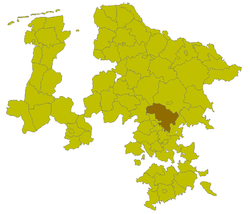Burgdorf | |
|---|---|
 | |
| Country | Germany |
| State | Lower Saxony |
| Disbanded | 1974 |
| Capital | Burgdorf |
| Area | |
• Total | 825.05 km2 (318.55 sq mi) |
| Population (1973) | |
• Total | 148,100 |
| • Density | 179.5/km2 (464.9/sq mi) |
| Time zone | UTC+01:00 (CET) |
| • Summer (DST) | UTC+02:00 (CEST) |
| Vehicle registration | BU |
The Burgdorf District is a former district (Landkreis) in Germany. It existed from 1885 to 1974, when it was absorbed in the Hanover District and subsequently in the Hanover Region. Its area corresponds roughly to the present day municipalities of Wedemark, Isernhagen, Burgwedel, Burgdorf, Uetze, Lehrte and Sehnde. [1] [2]
